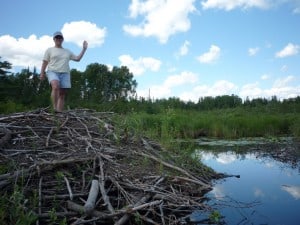Share this article
A Pond to Call Home: How Beavers Pick the Best Dam Water
Beaver ponds are a good indicator of beaver activity as well as beaver colony density, according to recent findings.
Carol Johnston, lead author of a new study published in the Journal of Wildlife Management and professor at South Dakota State University, first examined how shallow marsh helps predict declining beaver numbers in Minnesota’s Voyageurs National Park in the late 1980s. More recently, she set out with her co-author Steve Windels to see if this is still the case.
“Voyageurs has some of the densest beaver colony numbers in the country and in the world,” Johnston said. “It peaked in the 1990s and has been decreasing since then. There are still a lot of beavers in the landscape, but not as much of an abundance as in the 1990s.”
Using aerial photography as well as historical maps of beaver landscapes, the team built landscape models of beaver colony density based on models from the previous study that predicted colony density up to 1986.
“Now, it looks like pond water is more of a predictor of active beaver colonies,” Johnston said. “When beavers create dams, they impound water. It’s intuitive that beaver ponds are related to the number of beavers.”
One of the most interesting findings from the study was that beavers find sites that make the largest ponds and impound those first. Then, they occupy those ponds over a long period of time.
The researchers found that beaver numbers continue to decline, likely because they have exhausted forage around their beaver ponds, Johnston said. Beavers cut down woody plants and put them in piles under the water in the winter for a food supply. They move from the edges of the ponds out into the forest to retrieve vegetation, making them more vulnerable to predation outside of the ponds, she said. “The sites we’ve been assessing recently have not been as optimal,” she said. “The beaver population might have depleted some of those forage resources and decreased as a result.
However, some amount of decline is realistic as well as sustainable, Johnston said. The landscape was altered by logging and fire in the 1930s through 1960s, making aspen trees available, which are beavers’ preferred forage. “It was optimal for them to expand into,” she said. “But at one point, the population has to reach its carrying capacity and the population has to plateau. You have to get a balance of the number of beavers and sustainability of the forest.”
Header Image: A beaver lodge at Seney National Wildlife Refuge in Michigan. Image Credit: Tina Shaw/USFWS, licensed by cc 2.0









